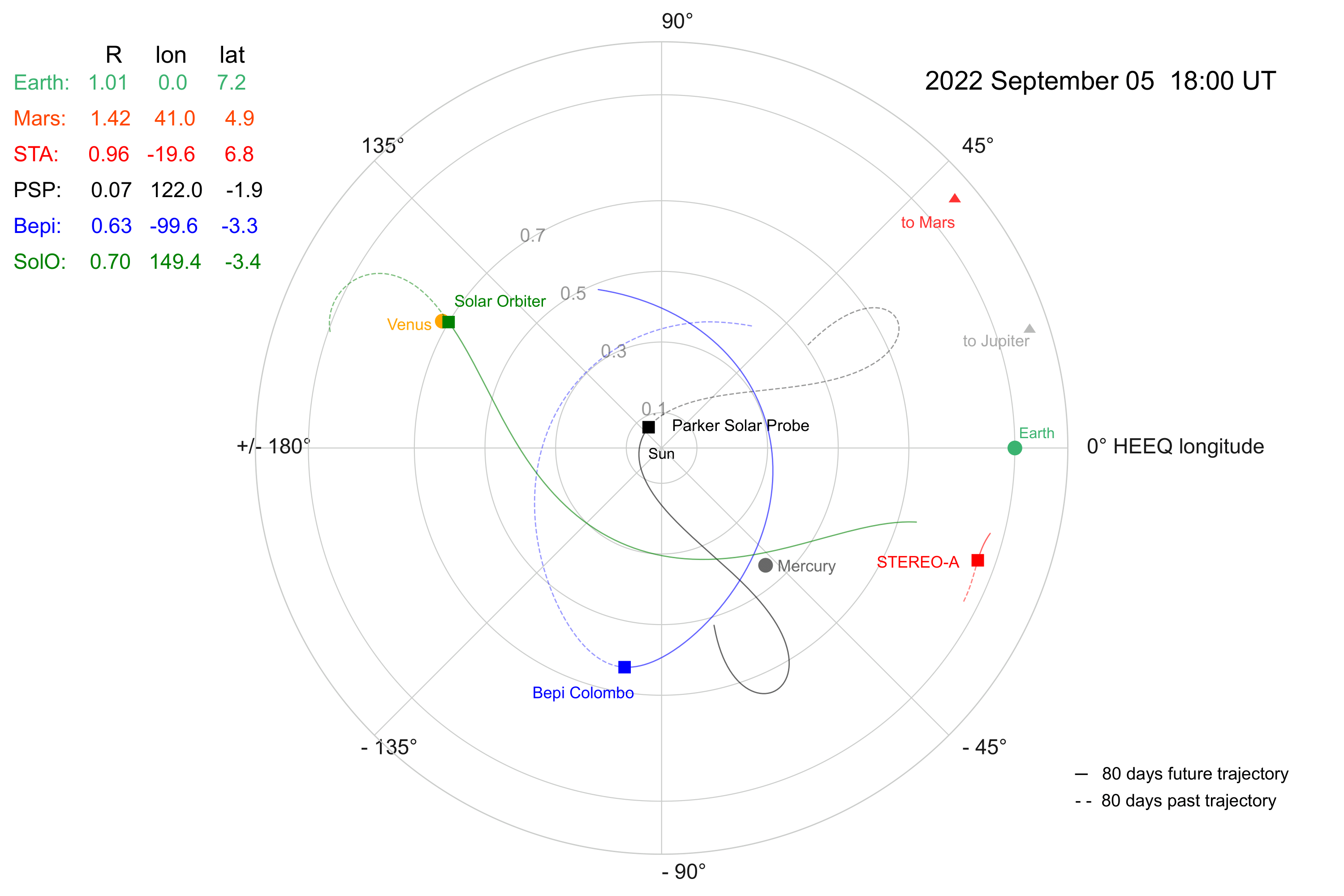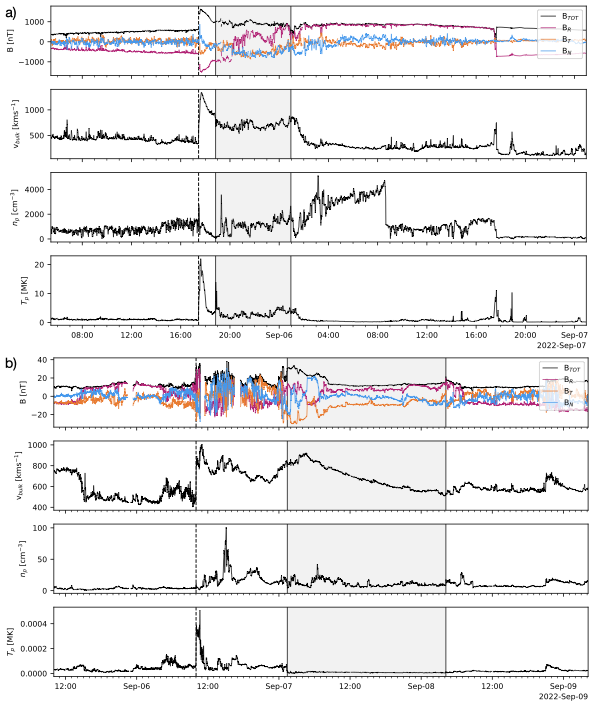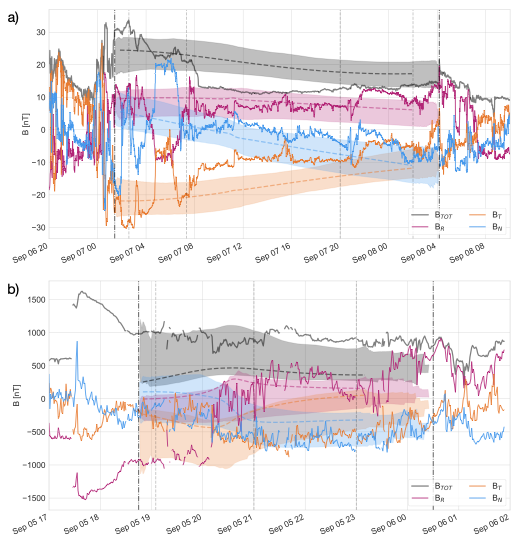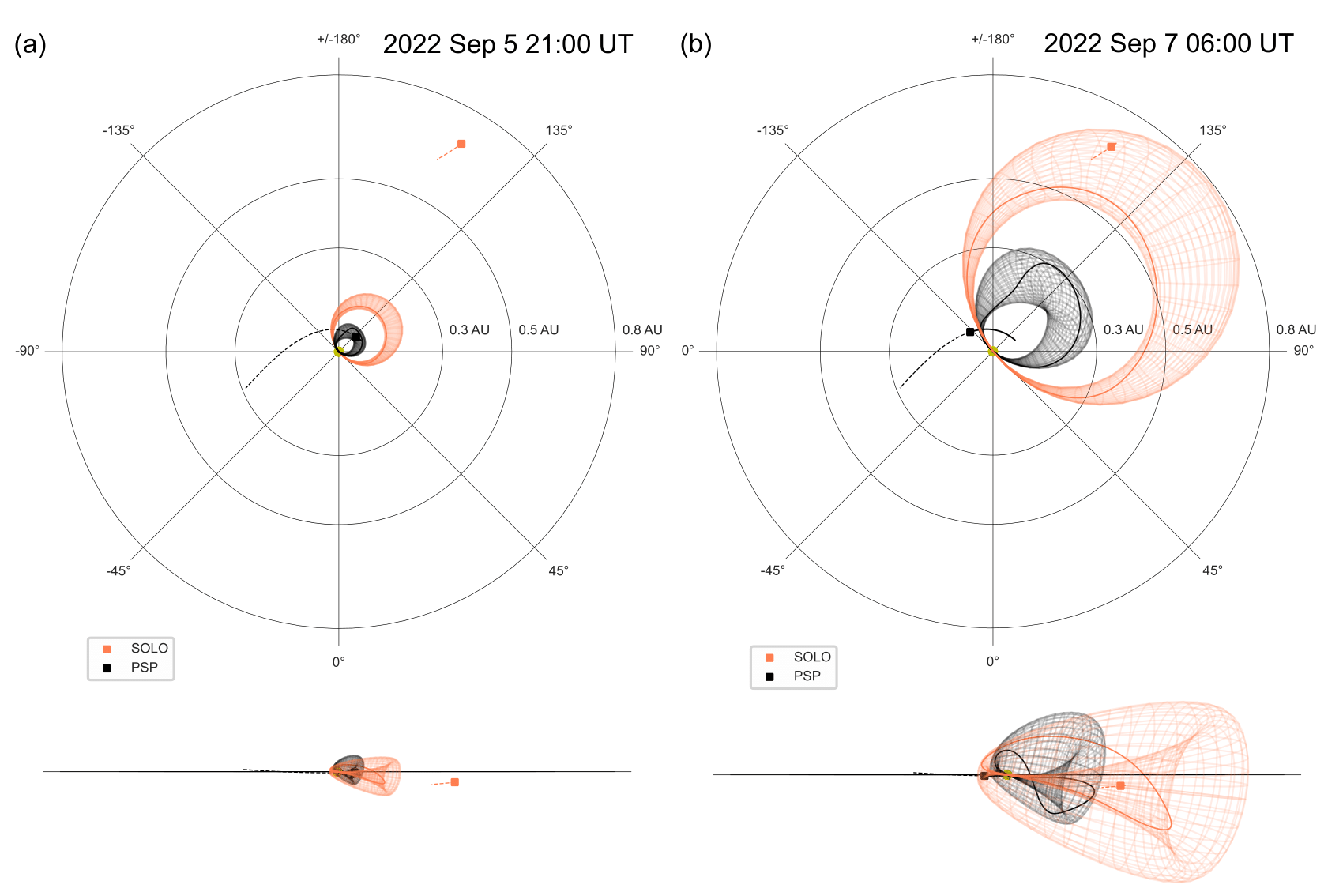Science nugget: Modelling the global structure of a coronal mass ejection observed by Solar Orbiter and Parker Solar Probe - Solar Orbiter
Modelling the global structure of a coronal mass ejection observed by Solar orbiter and parker solar probe
(Solar Orbiter Nugget #37 by Emma E. Davies1, Hannah T. Rüdisser1,2, Ute V. Amerstorfer1, Christian Möstl1, Maike Bauer1,2, Eva Weiler1,2, Tanja Amerstorfer1, Satabdwa Majumdar1, Phillip Hess3, Andreas J. Weiss4, Martin A. Reiss5, Lucie M. Green6, David M. Long7, Teresa Nieves-Chinchilla8,9, Domenico Trotta10, Timothy S. Horbury10, Helen O'Brien10, Edward Fauchon-Jones10, Jean Morris10, Christopher J. Owen6, Stuart D. Bale11, and Justin C. Kasper12)
Introduction
Reconstructing the global structure of coronal mass ejections is not a straightforward task: as CMEs propagate through the heliosphere, they may undergo many processes including rotations, deflections, interactions with other solar wind transients [1] that can lead to fundamental alterations [2] or deformations [3-6] of their structure.
To truly understand the global structure of ICMEs and their evolution as they propagate through the heliosphere, multi-spacecraft measurements of the same ICME over varying radial and longitudinal separations are necessary [7]. Previous multi-spacecraft ICME studies have found that although the evolution of ICME properties with increasing heliocentric distance is often consistent with previous statistical trends, individual ICMEs display significant variability [8-11].
As both Parker Solar Probe (PSP) and Solar Orbiter reach heliocentric distances closer to the Sun, they present an exciting opportunity to study the structure of CMEs in the inner heliosphere. The CME launched on 2022 September 5 is the subject of great interest [12-16], as it is the closest CME observed to Sun to date, observed by PSP at a heliocentric distance of just 0.07 AU, and later by Solar Orbiter at 0.69 AU (see Figure 1). Such a spacecraft configuration presents a unique opportunity for a direct comparison of ICME observations at an early stage of its evolution, with those much further in its evolution.

Figure 1: Spacecraft positions presented in Heliocentric Earth Equatorial (HEEQ) coordinates, on 2022 September 5 18:00 UT, around the time of arrival of the CME at PSP. Solar Orbiter is represented by the green square marker, and PSP by the black square marker. The spacecraft trajectories shown cover a time range of 80 days before (dashed) and after (solid) the event.
Spacecraft observations
The magnetic field and plasma observations observed at PSP and Solar Orbiter are presented in Figure 2a and b, respectively. The PSP observations show a fast-forward shock driven by the CME at 17:27 UT on 5 September. The grey shaded region represents the flux rope or magnetic ejecta (ME) of the CME, where the magnetic field magnitude, bulk proton velocity, proton density and proton temperature all remain fairly constant throughout the interval. These plasma properties are not the typical features observed near 1 AU and are indicative of a young ME at an early stage of its evolution.
The shock front of the CME arrived at 10:01 UT on 6 September at Solar Orbiter. The ME displays more typically observed plasma signatures including a declining bulk velocity profile. From the magnetic field measurements, the flux rope within the ME mostly rotates from North to South, meaning that we can assume a right-handed flux rope, with a low inclination with respect to the ecliptic plane. The observations of the flux rope in situ are consistent with the analysis of the remote observations of its solar source [12].

Figure 2: In situ magnetic and plasma data at PSP (a) and Solar Orbiter (b). The top panel presents the magnetic field data, where the magnetic field magnitude is shown in black, and the magnetic field components in Radial-Tangential-Normal (RTN) coordinates in magenta, orange, and blue, respectively. The following panels present the bulk proton velocity, proton density, and proton temperature of the solar wind, respectively. The vertical dashed line marks the time of the shock front, and the solid vertical lines mark the start and end of the ME, which is also represented by the grey shaded area.
Reconstructing the CME flux rope
To reconstruct the parameters of the flux rope of the CME observed in situ by PSP and Solar Orbiter, we use the semi-empirical 3D Coronal Rope Ejection (3DCORE) model [17-20]. The 3DCORE model is capable of fitting the magnetic field observations at each spacecraft to estimate parameters such as the propagation direction, inclination, and expansion rate of the CME flux rope. 3DCORE also has the ability to take into account the motion of the spacecraft, which is especially useful considering the faster movement of PSP in comparison to other spacecraft at further heliocentric distances.
For the case of the Solar Orbiter observations, 3DCORE was able to reconstruct the flux rope without too many adjustments of parameter fitting limits and in a short computational time (Figure 3a). The results obtained for the Solar Orbiter fit were then used to restrict the input parameter ranges for the PSP fit (Figure 3b). Despite the flux rope type being difficult to establish visually from the in situ observations, 3DCORE fits the PSP data relatively well when restricted to positive twist values, consistent with the Solar Orbiter in situ observations of a right-handed flux rope type.

Figure 3: Magnetic field measurements presented in RTN coordinates (solid lines) together with the 3DCORE flux rope ensemble at Solar Orbiter (a) and PSP (b). The shaded area corresponds to the 2s spread of the ensemble. The dashed coloured lines show one specific flux rope from the ensemble. The vertical black dashed lines mark the start and end of the reconstruction interval used by 3DCORE.
We find that although many parameter results are similar between the two fits, it is difficult to reconstruct a completely consistent global 3D structure between the in situ observations at PSP and Solar Orbiter (Figure 4). This is likely due to the single spacecraft trajectories through the CME, with large radial and longitudinal separations, as features often differ throughout the flux rope and are perhaps more localized to the in situ measurement site. When reconstructing and propagating the ICME, the difference between the background solar wind speeds produced by 3DCORE for PSP and Solar Orbiter were strongly apparent, with the low speed at PSP decelerating the CME significantly.

Figure 4: Representative flux ropes reconstructed by 3DCORE from the PSP (black) and Solar Orbiter (orange) observations, (a) at a time of observation of the magnetic ejecta by PSP (2022 Sep 5 21:00 UT) and (b) at a time of observation the magnetic ejecta at Solar Orbiter (2022 Sep 7 06:00 UT). The solid lines inside of the flux rope grids depict a magnetic field line and its twist. Top: top view down from solar equatorial north, bottom: side view along the solar equatorial plane. The black solid and dashed line shows the trajectory of PSP before and after the observation time; the orange dashed line is the trajectory of Solar Orbiter after the observation.
Conclusions
From our model fitting results, it is clear the solar wind background and drag regime strongly affects the modelled expansion and propagation of CMEs and needs to be considered.
These results underscore the importance of refining our models and questioning the validity of our assumptions for CME propagation as we seek to improve the accuracy of space weather forecasting tools. As PSP and Solar Orbiter continue their missions, validation of such models with in situ multi-spacecraft observations is crucial towards creating a more realistic picture of CME evolution across large heliocentric distance ranges and differing solar wind regimes, and incorporated into models continuing to improve our understanding of CME propagation throughout the heliosphere.
This article has been published in the Astrophysical Journal with DOI: https://doi.org/10.3847/1538-4357/ad64cb
Acknowledgements
E.D., U.V.A., H.T.R., C.M., and E.W. are funded by the European Union (ERC, HELIO4CAST, 101042188). Views and opinions expressed are however those of the author(s) only and do not necessarily reflect those of the European Union or the European Research Council Executive Agency. Neither the European Union nor the granting authority can be held responsible for them. M.B. and T.A. acknowledge that this research was funded in whole, or in part, by the Austrian Science Fund (FWF) [P 36093]. S.M. and M.A.R. acknowledge that this research was funded in whole, or in part, by the Austrian Science Fund (FWF) [P 34437]. For the purpose of open access, the author has applied a CC BY public copyright licence to any Author Accepted Manuscript version arising from this submission. D.T. received funding from the European Union’s Horizon 2020 research and innovation programme under grant agreement no.\ 101004159 (SERPENTINE, www.serpentine-h2020.eu). Views and opinions expressed are, however, those of the authors only and do not necessarily reflect those of the European Union or the European Research Council Executive Agency. Neither the European Union nor the granting authority can be held responsible for them. Solar Orbiter is a space mission run as an international collaboration between ESA and NASA and operated by ESA. Solar Orbiter magnetometer operations are funded by the UK Space Agency (grant ST/X002098/1). T.H. is supported by STFC grant ST/W001071/1. T.N-C. thanks for the support of the Solar Orbiter and Parker Solar Probe missions, Heliophysics Guest Investigator Grant 80NSSC23K0447 and the GSFC-Heliophysics Innovation Funds. Solar Orbiter SWA data were derived from scientific sensors that were designed and created and are operated under funding provided by numerous contracts from UKSA, STFC, the Italian Space Agency, CNES, the French National Centre for Scientific Research, the Czech contribution to the ESA PRODEX programme and NASA. SO SWA work at the UCL/Mullard Space Science Laboratory is currently funded by STFC (Grant Nos. ST/W001004/1 and ST/X/002152/1). P.H. acknowledges the support of the PSP program office and the Office of Naval Research. Parker Solar Probe was designed, built, and is now operated by the Johns Hopkins Applied Physics Laboratory as part of NASA's Living with a Star (LWS) program (contract NNN06AA01C). Support from the LWS management and technical team has played a critical role in the success of the Parker Solar Probe mission. The Wide-Field Imager for Parker Solar Probe (WISPR) instrument was designed, built, and is now operated by the US Naval Research Laboratory in collaboration with Johns Hopkins University/Applied Physics Laboratory, California Institute of Technology/Jet Propulsion Laboratory, University of Gottingen, Germany, Centre Spatiale de Liege, Belgium and University of Toulouse/Research Institute in Astrophysics and Planetology.
Affiliations
1 Austrian Space Weather Office, GeoSphere Austria, Graz, Austria
2 Institute of Physics, University of Graz, Graz, Austria
3 U.S. Naval Research Laboratory, Washington, DC 20375, USA
4 NASA Postdoctoral Program Fellow, NASA Goddard Space Flight Center, Greenbelt, MD 20771, USA
5 Community Coordinated Modeling Center, NASA Goddard Space Flight Center, Greenbelt, MD 20771, USA
6 Mullard Space Science Laboratory, University College London, Holmbury St. Mary, Dorking, Surrey, RH5 6NT, UK
7 School of Physical Sciences, Dublin City University, Glasnevin Campus, Dublin, D09 V209, Ireland
8 Heliophysics Science Division, NASA Goddard Space Flight Center, Greenbelt, MD 20771, USA
9 Department of Physics and Astronomy, George Mason University, Fairfax, VA 22030-4444, USA
10 Imperial College London, South Kensington Campus, London, SW7 2AZ, UK
11 Physics Department and Space Sciences Laboratory, University of California, Berkeley, CA 94720, USA
12 School of Climate and Space Sciences and Engineering, University of Michigan, Ann Arbor, MI 48109-2143, USA
References
[1] Manchester W., Kilpua E. K. J., Liu Y. D. et al. 2017, SSRv, 212, 1159
[2] Scolini C., Winslow R. M., Lugaz N. et al. 2022, ApJ, 927, 102
[3] Riley P. and Crooker N. U. 2004, ApJ, 600, 1035
[4] Owens M. J., Merkin V. G. and Riley P. 2006, JGRA, 111, A03104
[5] Savani N. P., Owens M. J., Rouillard A. P. et al. 2010, ApJL, 714, L128
[6] Davies E. E., Möstl C., Owens M. J. et al. 2021b, A&A, 656, A2
[7] Lugaz N., Farrugia C. J., Winslow R. M. et al. 2018, ApJL, 864, L7
[8] Good S. W., Forsyth R. J., Eastwood J. P. et al. 2018, SoPh, 293, 52
[9] Salman T. M., Winslow R. M. and Lugaz N. 2020, JGRA, 125, e27084
[10] Davies E. E., Winslow R. M., Scolini C. et al. 2022, ApJ, 933, 127
[11] Möstl C., Weiss A. J., Reiss M. A. et al. 2022, ApJL, 924, L6
[12] Long D. M., Green L. M., Pecora F. et al. 2023, ApJ, 955, 152
[13] Romeo O. M., Braga C. R., Badman S. T. et al. 2023, ApJ, 954, 168
[14] Patel R., West M. J., Seaton D. B. et al. 2023, ApJL, 955, L1
[15] Trotta D., Larosa A., Nicolaou G. et al. 2024, ApJ, 962, 147
[16] Liu Y. D., Zhu B., Ran H. et al. 2024, ApJ, 963, 85
[17] Möstl C., Amerstorfer T., Palmerio E. et al. 2018, SpWea, 16, 216
[18] Weiss A. J., Möstl C., Davies E. E. et al. 2021a, A&A, 656, A13
[19] Weiss A. J., Möstl C., Amerstorfer T. et al. 2021b, ApJS, 252, 9
[20] Rüdisser H., Weiss A., Le Louëdec J. et al. 2024, ApJ, in press
- Removed a total of (4) style margin:0;
Nuggets archive
2025
19/03/2025: Radial dependence of solar energetic particle peak fluxes and fluences
12/03/2025: Analysis of solar eruptions deflecting in the low corona
05/03/2025: Propagation of particles inside a magnetic cloud: Solar Orbiter insights
19/02/2025: Rotation motions and signatures of the Alfvén waves in a fan-spine topology
12/02/2025: 'Sun'day everyday: 2 years of Solar Orbiter science nuggets that shed light on some of our star's mysteries
22/01/2025: Velocity field in the solar granulation from two-vantage points
15/01/2025: First joint X-ray solar microflare observations with NuSTAR and Solar Orbiter/STIX
2024
18/12/2024: Shocks in tandem : Solar Orbiter observes a fully formed forward-reverse shock pair in the inner heliosphere
11/12/2024: High-energy insights from an escaping coronal mass ejection
04/12/2024: Investigation of Venus plasma tail using the Solar Orbiter, Parker Solar Probe and Bepi Colombo flybys
27/11/2024: Testing the Flux Expansion Factor – Solar Wind Speed Relation with Solar Orbiter data
20/11/2024:The role of small scale EUV brightenings in the quiet Sun coronal heating
13/11/2024: Improved Insights from the Suprathermal Ion Spectrograph on Solar Orbiter
30/10/2024: Temporally resolved Type III solar radio bursts in the frequency range 3-13 MHz
23/10/2024: Resolving proton and alpha beams for improved understanding of plasma kinetics: SWA-PAS observations
25/09/2024: All microflares that accelerate electrons to high-energies are rooted in sunspots
25/09/2024: Connecting Solar Orbiter and L1 measurements of mesoscale solar wind structures to their coronal source using the Adapt-WSA model
18/09/2024: Modelling the global structure of a coronal mass ejection observed by Solar Orbiter and Parker Solar Probe
28/08/2024: Coordinated observations with the Swedish 1m Solar Telescope and Solar Orbiter
21/08/2024: Multi-source connectivity drives heliospheric solar wind variability
14/08/2024: Composition Mosaics from March 2022
19/06/2024: Coordinated Coronal and Heliospheric Observations During the 2024 Total Solar Eclipse
22/05/2024: Real time space weather prediction with Solar Orbiter
15/05/2024: Hard X ray and microwave pulsations: a signature of the flare energy release process
01/02/2024: Relativistic electrons accelerated by an interplanetary shock wave
11/01/2024: Modelling Two Consecutive Energetic Storm Particle Events observed by Solar Orbiter
2023
14/12/2023: Understanding STIX hard X-ray source motions using field extrapolations
16/11/2023: EUI data reveal a "steady" mode of coronal heating
09/11/2023: A new solution to the ambiguity problem
02/11/2023: Solar Orbiter and Parker Solar Probe jointly take a step forward in understanding coronal heating
25/10/2023: Observations of mini coronal dimmings caused by small-scale eruptions in the quiet Sun
18/10/2023: Fleeting small-scale surface magnetic fields build the quiet-Sun corona
27/09/2023: Solar Orbiter reveals non-field-aligned solar wind proton beams and its role in wave growth activities
20/09/2023: Polarisation of decayless kink oscillations of solar coronal loops
23/08/2023: A sharp EUI and SPICE look into the EUV variability and fine-scale structure associated with coronal rain
02/08/2023: Solar Flare Hard Xrays from the anchor points of an eruptive filament
28/06/2023: 3He-rich solar energetic particle events observed close to the Sun on Solar Orbiter
14/06/2023: Observational Evidence of S-web Source of Slow Solar Wind
31/05/2023: An interesting interplanetary shock
24/05/2023: High-resolution imaging of coronal mass ejections from SoloHI
17/05/2023: Direct assessment of far-side helioseismology using SO/PHI magnetograms
10/05/2023: Measuring the nascent solar wind outflow velocities via the doppler dimming technique
26/04/2023: Imaging and spectroscopic observations of EUV brightenings using SPICE and EUI on board Solar Orbiter
19/04/2023: Hot X-ray onset observations in solar flares with Solar Orbiter/STIX
12/04/2023: Multi-scale structure and composition of ICME prominence material from the Solar Wind Analyser suite
22/03/2023: Langmuir waves associated with magnetic holes in the solar wind
15/03/2023: Radial dependence of the peak intensity of solar energetic electron events in the inner heliosphere
08/03/2023: New insights about EUV brightenings in the quiet sun corona from the Extreme Ultraviolet Imager








































 Sign in
Sign in
 Science & Technology
Science & Technology